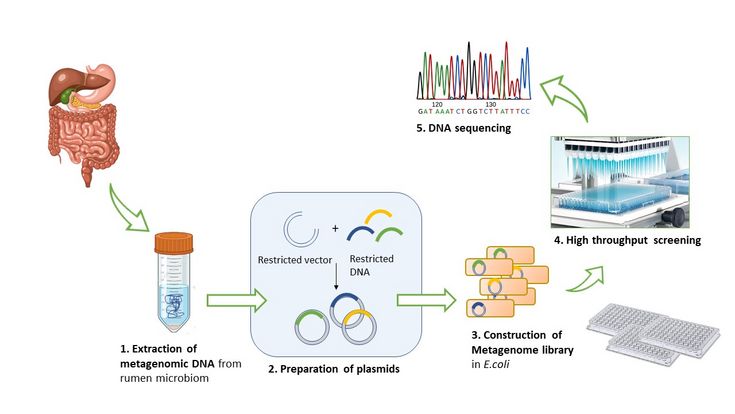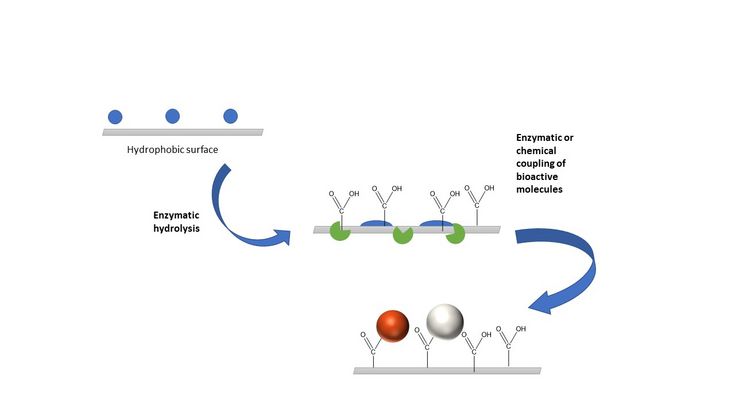Biofunctionalisation and processing of polyester-based materials using novel enzymes
SUPERVISOR: Georg M. GÜBITZ
PROJECT ASSIGNED TO: Chiara SIRACUSA
This project will investigate in detail hydrolysis reactions of Polyethylene terephthalate (PET) and other polyesters through well characterized and novel enzymes produced in either prokaryotic or eukaryotic systems. The research will be performed in the context of UPLIFT (sUstainable PLastIcs for the Food and drink packaging industry) European project, which addresses the plastic packaging process from monomer production to packaging material manufacturing and back to end of life reusing and recycling options [1].
Plastic-based pollution is one of the most serious threats to the environment, especially PET related. Compared to mechanical, thermal and chemical-based treatments, enzyme based methods are expected to be more specific and environmentally friendly. PET hydrolases have been recently investigated related to hydrolysis of PET both for surface functionalisation as well as for complete decomposition. Various factors, specifically PET crystallinity, temperature, and pH are known to affect this enzymatic process. Accordingly, the first task of this project involves the screening of thermostable enzymes or enhancing the thermostability of known biocatalysts via enzyme engineering [2].
The aim of this thesis also involves the optimization of enzymatic hydrolysis of polyesters. Different parameters (temperature, incubation time, various pre-treatments and optimization mass transfer substrate/enzyme) will be modulated in the application of already used enzymes. For example, some additives have been proved to increase enzymatic activity of the typic PET hydrolysis enzymes, such as cutinases [3]. Moreover, the identification of novel enzymes from microbial communities will be investigated using transcriptomic and proteomic methodologies, in order to improve the range of available tools for polyester biofunctionalization and processing [4].

Figure 1. Hypothetic workflow of a metagenomic investigation of microbioma derived hydrolytic enzymes
Recently some biodegradable alternatives to PET have been commercialised, such as PBAT (Polybutylene adipate-co-terephthalate) and PLA (Polylactide) with an overall good applicability. Like for PET, their hydrolysis can be also performed by means of enzymes, and analogous approaches will be tested. Furthermore, despite the outstanding number of applications of PET, the hydrophobicity and inert features of PET has advantages in several applications but results as a manufacturing limitation when surface functionalisation (e.g. antimicrobial) is desired e.g. for biomedical applications. For example, functionalization is nowadays performed by alkali treatment which however partially destroys the material leading to strength losses. Different studies show an increase of hydrophilicity by limited hydrolysis of backbone ester bonds via enzymatic approach [5] which leads to the introduction of carboxyl and hydroxyl groups allowing coupling of bioactive molecules. Therefore, another objective of this project would be the improvement of techniques for PET enzymatic surface functionalization in order to go beyond the conventional chemical finishing techniques. Several analytical approaches will be also tested orthogonally to obtain a full characterization of the chemical, physical and structural changes in polyester surface.

Figure 2. Schematic representation of surface functionalization by means of hydrolytic enzymes.
References
1. UPLIFT Upcycling Bio Plastics of food and drinks packaging (2021, November 3). UPLIFT. Retrieved from upliftproject.eu
2. Maurya A, Bhattacharya A, Khare SK. Enzymatic Remediation of Polyethylene Terephthalate (PET)- Based Polymers for Effective Management of Plastic Wastes: An Overview. Front Bioeng Biotechnol. 2020 Nov 19;8:602325. doi: 10.3389/fbioe.2020.602325. PMID: 33330434; PMCID: PMC7710609.
3. Furukawa, M., Kawakami, N., Tomizawa, A. et al. Efficient Degradation of Poly(ethylene terephthalate) with Thermobifida fusca Cutinase Exhibiting Improved Catalytic Activity Generated using Mutagenesis and Additive-based Approaches. Sci Rep 9, 16038 (2019). doi.org/10.1038/s41598-019-52379-z
4. Quartinello Felice, Kremser Klemens, Schoen Herta, Tesei Donatella, Ploszczanski Leon, Nagler Magdalena, Podmirseg Sabine M., Insam Heribert, Piñar Guadalupe, Sterflingler Katja, Ribitsch Doris, Guebitz Georg M. (2021). Together Is Better: The Rumen Microbial Community as Biological Toolbox for Degradation of Synthetic Polyesters. Frontiers in Bioengineering and Biotechnology. 9. 684459. 10.3389/fbioe.2021.684459.
5. Ilaria Donelli; Paola Taddei; Philippe F. Smet; Dirk Poelman; Vincent A. Nierstrasz; Giuliano Freddi (2009). Enzymatic surface modification and functionalization of PET: A water contact angle, FTIR, and fluorescence spectroscopy study. , 103(5), 845–856. doi:10.1002/bit.22316
